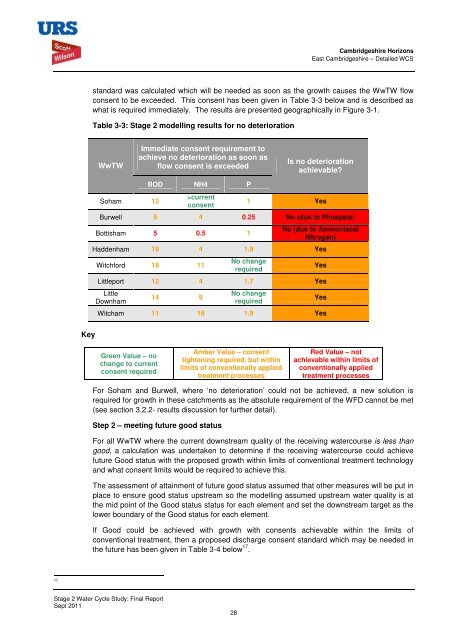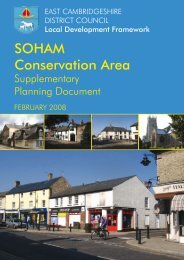East Cambridgeshire District Council Water Cycle Study Detailed ...
East Cambridgeshire District Council Water Cycle Study Detailed ...
East Cambridgeshire District Council Water Cycle Study Detailed ...
You also want an ePaper? Increase the reach of your titles
YUMPU automatically turns print PDFs into web optimized ePapers that Google loves.
17<br />
Key<br />
Stage 2 <strong>Water</strong> <strong>Cycle</strong> <strong>Study</strong>: Final Report<br />
Sept 2011<br />
28<br />
<strong>Cambridgeshire</strong> Horizons<br />
<strong>East</strong> <strong>Cambridgeshire</strong> – <strong>Detailed</strong> WCS<br />
standard was calculated which will be needed as soon as the growth causes the WwTW flow<br />
consent to be exceeded. This consent has been given in Table 3-3 below and is described as<br />
what is required immediately. The results are presented geographically in Figure 3-1.<br />
Table 3-3: Stage 2 modelling results for no deterioration<br />
WwTW<br />
Soham 12<br />
Immediate consent requirement to<br />
achieve no deterioration as soon as<br />
flow consent is exceeded<br />
BOD NH4 P<br />
>current<br />
consent<br />
Is no deterioration<br />
achievable?<br />
1 Yes<br />
Burwell 9 4 0.25 No (due to Phospate)<br />
Bottisham 5 0.5 1<br />
No (due to Ammoniacal<br />
Nitrogen)<br />
Haddenham 19 4 1.9 Yes<br />
Witchford 18 11<br />
No change<br />
required<br />
Yes<br />
Littleport 12 4 1.7 Yes<br />
Little<br />
Downham<br />
14 9<br />
No change<br />
required<br />
Yes<br />
Witcham 11 18 1.9 Yes<br />
Green Value – no<br />
change to current<br />
consent required<br />
Amber Value – consent<br />
tightening required, but within<br />
limits of conventionally applied<br />
treatment processes<br />
Red Value – not<br />
achievable within limits of<br />
conventionally applied<br />
treatment processes<br />
For Soham and Burwell, where ‘no deterioration’ could not be achieved, a new solution is<br />
required for growth in these catchments as the absolute requirement of the WFD cannot be met<br />
(see section 3.2.2- results discussion for further detail).<br />
Step 2 – meeting future good status<br />
For all WwTW where the current downstream quality of the receiving watercourse is less than<br />
good, a calculation was undertaken to determine if the receiving watercourse could achieve<br />
future Good status with the proposed growth within limits of conventional treatment technology<br />
and what consent limits would be required to achieve this.<br />
The assessment of attainment of future good status assumed that other measures will be put in<br />
place to ensure good status upstream so the modelling assumed upstream water quality is at<br />
the mid point of the Good status status for each element and set the downstream target as the<br />
lower boundary of the Good status for each element.<br />
If Good could be achieved with growth with consents achievable within the limits of<br />
conventional treatment, then a proposed discharge consent standard which may be needed in<br />
the future has been given in Table 3-4 below 17 .






